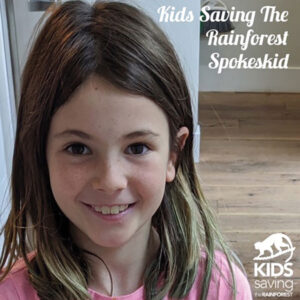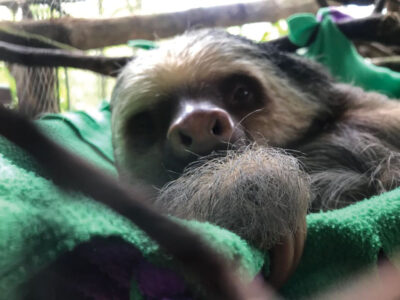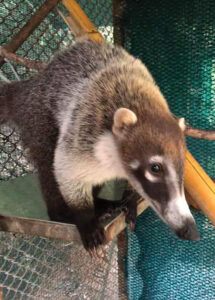Kids Saving The Rainforest Wildlife Sanctuary Diet

 For this Quepolandia issue, our KSTR President, Jennifer, met with KSTR Spokeskid, Dani, and her parents in San Francisco, where they all live part time, to discuss Dani’s articles. Dani already had about 10 articles in her head, all of which her dad will type up while Dani dictates. Dani is all of 7 years old!
For this Quepolandia issue, our KSTR President, Jennifer, met with KSTR Spokeskid, Dani, and her parents in San Francisco, where they all live part time, to discuss Dani’s articles. Dani already had about 10 articles in her head, all of which her dad will type up while Dani dictates. Dani is all of 7 years old!
Take it away Dani!
Hi, my name is Dani, and I am the spokeskid for KSTR. Today I want to talk about what the animals eat, and why we feed them what we feed them.
 First, we have the monkeys. Usually, for the monkeys, in the morning, we give them a fruit salad with Watermelon, Papaya, and other good fruit. In the afternoon, we mix the same fruit salad, but add some vegetables—for example we add sweet potatoes, carrots, and green beans. We give them these foods because all the animals in our sanctuary were at one point in the wild, and the food we’re giving them is like the diet they would have had in the wild. In case you haven’t noticed, monkeys spend a lot of time jumping from tree to tree, across branches. One of the reasons they are doing that, is to look for food—many of the fruits in their diet at KSTR grow in trees in Costa Rica! At the sanctuary, we had 3 squirrel monkeys who needed medicine. They did NOT like the flavor of the medicine. So, we used a syringe to squirt the medicine into a marshmallow, which everybody knows monkeys love! (We normally try to only feed our animals natural food that comes from their habitats, but when we need to get medicine into them, we sometimes use small treats.)
First, we have the monkeys. Usually, for the monkeys, in the morning, we give them a fruit salad with Watermelon, Papaya, and other good fruit. In the afternoon, we mix the same fruit salad, but add some vegetables—for example we add sweet potatoes, carrots, and green beans. We give them these foods because all the animals in our sanctuary were at one point in the wild, and the food we’re giving them is like the diet they would have had in the wild. In case you haven’t noticed, monkeys spend a lot of time jumping from tree to tree, across branches. One of the reasons they are doing that, is to look for food—many of the fruits in their diet at KSTR grow in trees in Costa Rica! At the sanctuary, we had 3 squirrel monkeys who needed medicine. They did NOT like the flavor of the medicine. So, we used a syringe to squirt the medicine into a marshmallow, which everybody knows monkeys love! (We normally try to only feed our animals natural food that comes from their habitats, but when we need to get medicine into them, we sometimes use small treats.)

 Second, we have the sloths. We feed the sloths only once a day, in the afternoon, because they are nocturnal. We usually feed them sweet potatoes, carrots, and green beans. Sometimes, the sloths will move a little faster than usual to get to their food if they are very hungry—but it’s hard to tell the difference to be honest! We have a sloth at our sanctuary, named Fossi, who needs medicine every single day. To feed it to her, we put the medicine into a syringe, which goes into her mouth and slowly squirts it in. To make sure she eats it, we give it to her before her meal, so she’s very hungry.
Second, we have the sloths. We feed the sloths only once a day, in the afternoon, because they are nocturnal. We usually feed them sweet potatoes, carrots, and green beans. Sometimes, the sloths will move a little faster than usual to get to their food if they are very hungry—but it’s hard to tell the difference to be honest! We have a sloth at our sanctuary, named Fossi, who needs medicine every single day. To feed it to her, we put the medicine into a syringe, which goes into her mouth and slowly squirts it in. To make sure she eats it, we give it to her before her meal, so she’s very hungry.
 Lastly, we have the Coatimundis, also called Coatis (which is a member of the Racoon family). One of our Coatimundis loves to eat so much, that he will eat his sister’s food after he finishes his own (like my daddy!). To stop this from happening, we fashioned a feeding stall setup to temporarily separate the Coatimundis using a sliding metal door, so they can eat their own food, but not steal from their siblings!
Lastly, we have the Coatimundis, also called Coatis (which is a member of the Racoon family). One of our Coatimundis loves to eat so much, that he will eat his sister’s food after he finishes his own (like my daddy!). To stop this from happening, we fashioned a feeding stall setup to temporarily separate the Coatimundis using a sliding metal door, so they can eat their own food, but not steal from their siblings!
To wrap this all up, all of the animals have a different way of eating their own diet, and each one of them are special. At KSTR, we try really hard to give them great food and good service. I love the animals so much at the sanctuary, and I can’t wait to tell you more about them next time!
